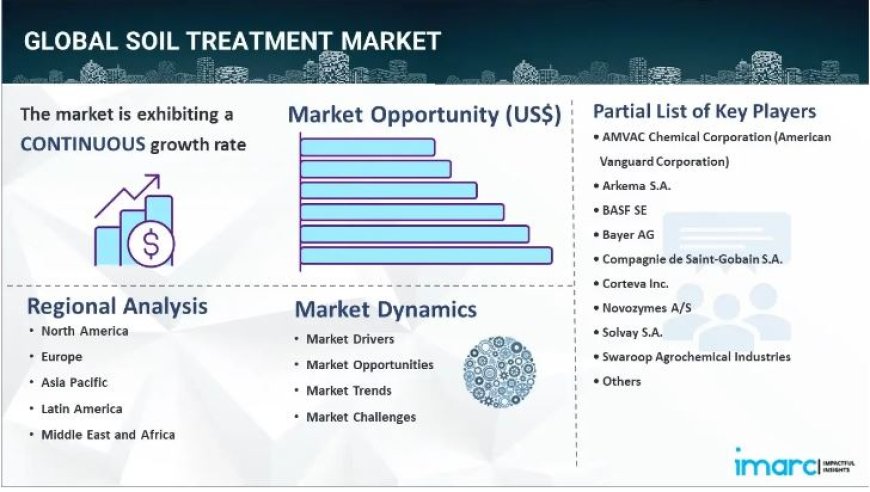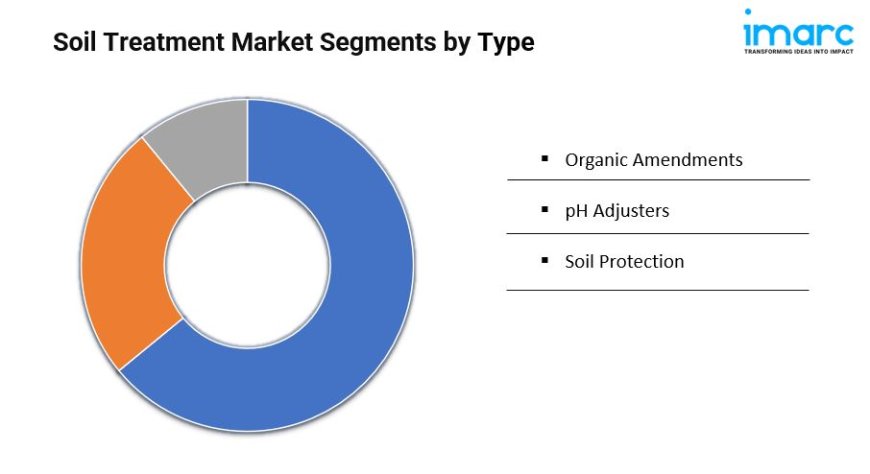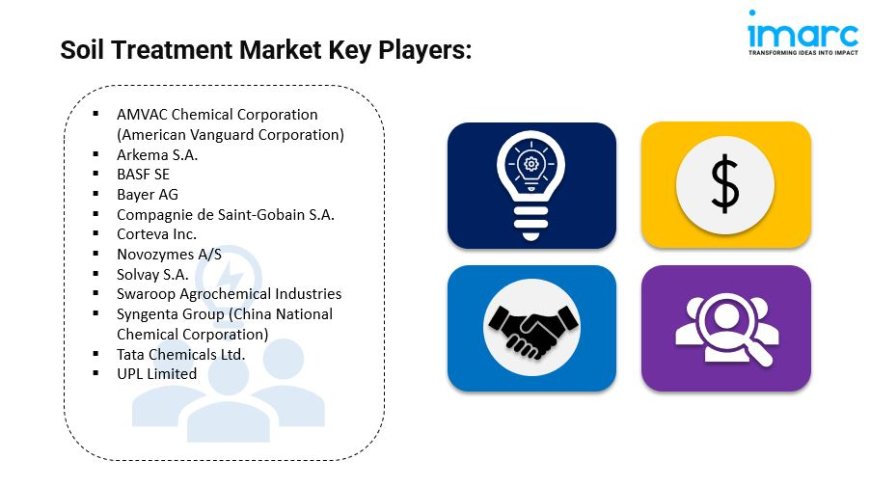Soil Treatment Market Report 2024-2032: Industry Trends, Segmentation and Forecast Analysis
The global soil treatment market size reached US$ 43.1 Billion in 2023. Looking forward, IMARC Group expects the market to reach US$ 68.1 Billion by 2032, exhibiting a growth rate (CAGR) of 5.1% during 2024-2032.

Summary:
- The global soil treatment market size reached USD 43.1 Billion in 2023.
- The market is expected to reach USD 68.1 Billion by 2032, exhibiting a growth rate (CAGR) of 5.1% during 2024-2032.
- North America leads the market, accounting for the largest soil treatment market share due to its advanced agricultural practices and significant investments in soil management.
- pH adjusters account for the majority of the market share in the type segment as they are important for improving soil conditions.
- Physiochemical treatment holds the largest share in the soil treatment industry because they are widely utilized to improve soil quality.
- The agricultural sector remains a dominant segment in the market because maintaining soil health is important for crop productivity.
- The rising demand for agricultural productivity globally is a primary driver of the soil treatment market.
- The increasing awareness about soil degradation and adoption of sustainable farming practices are reshaping the soil treatment market.

Request to Get the Sample Report: https://www.imarcgroup.com/soil-treatment-market/requestsample
Industry Trends and Drivers:
- Increasing Agricultural Productivity:
The demand for agricultural productivity is a primary factor driving the soil treatment market growth. As the global population continues to rise, there is an urgent need to enhance food production to ensure food security. Traditional agricultural methods often lead to soil degradation, nutrient depletion, and reduced crop yields. Soil treatment solutions, including fertilizers, organic amendments, and soil conditioners, play a critical role in revitalizing soil health and improving its fertility.
By optimizing the soil structure and nutrient availability, these treatments enable crops to thrive, thereby increasing overall productivity. Additionally, with the rising consumer awareness about the importance of sustainable farming practices, farmers are increasingly seeking innovative solutions that not only boost yields but also maintain soil health over the long term.
- Soil Degradation Awareness:
Growing awareness of soil degradation issues is significantly influencing the soil treatment market. Factors such as erosion, contamination, and nutrient depletion are increasingly recognized as critical challenges that threaten agricultural sustainability and productivity. Soil degradation not only diminishes crop yields but also adversely affects water quality and biodiversity, leading to long-term environmental consequences.
As farmers and agricultural stakeholders become more informed about the impact of poor soil health on their operations and the ecosystem, there is a rising demand for effective soil treatment practices. Educational initiatives and research highlighting the importance of soil conservation and restoration are encouraging farmers to adopt proactive measures, such as soil amendments, cover cropping, and reduced tillage, to enhance soil health.
- Sustainable Farming Practices:
The shift towards sustainable farming practices is a crucial driver of growth in the soil treatment market. As consumers increasingly prioritize environmentally friendly food production, farmers are compelled to adopt practices that minimize their ecological footprint. Sustainable agriculture emphasizes the importance of maintaining soil health through organic amendments, reduced chemical inputs, and efficient resource management. Soil treatment solutions that enhance soil fertility while promoting biological activity are essential to this paradigm shift. For instance, the use of compost, biochar, and cover crops enriches the soil with organic matter, which improves moisture retention, nutrient availability, and overall soil structure.
Furthermore, sustainable practices often include soil testing and monitoring to inform treatment decisions, allowing for precise interventions tailored to specific soil conditions. This data-driven approach not only optimizes soil treatments but also ensures that resources are used efficiently, reducing waste and promoting resilience in agricultural systems.
Speak to An Analyst: https://www.imarcgroup.com/request?type=report&id=4643&flag=C
Soil Treatment Market Report Segmentation:
Breakup By Type:
- Organic Amendments
- pH Adjusters
- Soil Protection
pH adjusters account for the majority of shares as they are essential for optimizing soil conditions and nutrient availability.

Breakup By Technology:
- Biological Treatment
- Thermal Treatment
- Physiochemical Treatment
Physiochemical treatment dominates the market because they are widely utilized for their effectiveness in improving soil quality and addressing specific soil issues.
Breakup By End User:
- Agricultural
- Construction
- Others
The agricultural sector represents the majority of shares as maintaining soil health is vital for enhancing crop productivity and ensuring food security.
Breakup By Region:
- North America
- United States
- Canada
- Asia-Pacific
- China
- Japan
- India
- South Korea
- Australia
- Indonesia
- Others
- Europe
- Germany
- France
- United Kingdom
- Italy
- Spain
- Russia
- Others
- Latin America
- Brazil
- Mexico
- Others
- Middle East and Africa
North America holds the leading position owing to its advanced agricultural practices, significant investments in soil management technologies, and a strong focus on sustainable farming initiatives.
Top Soil Treatment Market Leaders: The soil treatment market research report outlines a detailed analysis of the competitive landscape, offering in-depth profiles of major companies.
Some of the key players in the market are:
- AMVAC Chemical Corporation (American Vanguard Corporation)
- Arkema S.A.
- BASF SE
- Bayer AG
- Compagnie de Saint-Gobain S.A.
- Corteva Inc.
- Novozymes A/S
- Solvay S.A.
- Swaroop Agrochemical Industries
- Syngenta Group (China National Chemical Corporation)
- Tata Chemicals Ltd.
- UPL Limited

If you require any specific information that is not covered currently within the scope of the report, we will provide the same as a part of the customization.
About Us:
IMARC Group is a global management consulting firm that helps the world’s most ambitious changemakers to create a lasting impact. The company provide a comprehensive suite of market entry and expansion services. IMARC offerings include thorough market assessment, feasibility studies, company incorporation assistance, factory setup support, regulatory approvals and licensing navigation, branding, marketing and sales strategies, competitive landscape and benchmarking analyses, pricing and cost research, and procurement research.
Contact US:
IMARC Group
134 N 4th St. Brooklyn, NY 11249, USA
Email: sales@imarcgroup.com
Tel No: (D) +91 120 433 0800
United States: +1–631–791–1145

 businessnews
businessnews 










